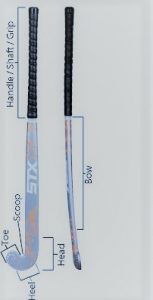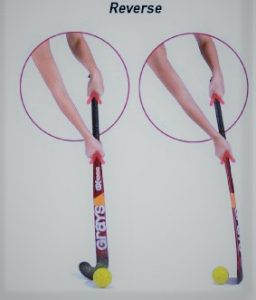The first thing to learn as a newbie in field hockey is how to hold the hockey stick. This is because the grip of a player keeps on changing depending on the ball handing situation during the game.
The player will be required to dribble, slap, push, or hit the ball. All these tasks require a different hold of the hockey stick. Knowledge of how to properly grip a hockey stick will help in improving both the hitting power and control of the ball.
All the best hockey sticks are made for the right hand. This makes the gripping of the stick the same to all players both the left-handed and the right-handed. Other left-handed players still get used to their leftie.
The main aim here is a player getting comfortable with the grip and be able to adjust to fit in his or her playing style. In this article, we offer some of the crucial ways to hold a hockey stick and become a star at it.
The 7 Field Hockey Grip Techniques

The field hockey grip techniques include;
- Basic Grip
- Reverse Grip
- Double- V Grip
- Short-handle Grip
- Frying-Pan Grip
- Left-handed Grip (one hand)
- Right-handed Grip (one hand)
-
The Basic Grip
In this style of holding the stick, your right hand should be at the base of the stick grip while the left hand at the top. In this case, we are using the word ‘grip’ to mean the leather-like material used to cover some part of the shaft of the stick.
The area at which the thumb and index finger meets forms a ‘V’ shape. This ‘V’ of both hands should face the curved part of the stick.
Uses of Basic Grip
- Dribbling the ball
- Certain stops of the ball
- Can also be used in hitting the ball
Coordination tactics for Basic Grip
The left hand should always turn and maneuver the stick while the right-hand remains in place to control the ball. In case you need to reverse the stick to left, rotate your left hand (which is at the top of the stick) to the right side while your right-hand remains in place but loose.
The stick should rotate a complete 180 degrees over the ball. The front side of the stick (flat side) then faces right. The curve (toe of the stick) points behind the player. Consecutively, the flat side of the stick then will lie against the left side of the ball.
-
The Reverse Grip

In this case, the basic grip is required. In other words, the reverse grip is an advancement of the basic grip.
While at the position of the basic grip, lie your stick against its’ flat side. The flat side of the stick will be facing upwards.
Uses of a Reverse Grip
- It is used to scoop the ball
- Used to receive an aerial pass and placing it to the ground
- It is used for flicks
-
Double-V Grip

This gripping of the stick involves both hands of the player be at the top part of the stick. The right-hand gets to the position of the left hand.
It can either slightly cover the left hand or slightly below it. The V should face the curve part of the stick.
You can grab or view the current price of GRAYS GR6000 Dynabow Field Hockey Stick on Amazon
Uses of the Double-V Grip
- It is used for powerful hits of the ball
Coordination tactics for Double-V Grip
When both hands are placed together at the top of the stick, the player can concentrate on their force and thus increasing the hit power. Whenever there is a space between the hands, the hit weakens.
-
Short-Handle Grip
This involves both hands in the same position just like the Double-v but in this case, the hands are at the midway of the stick. The V should face the curve part of the stick.
Uses of the Short- Handled Grip
- It is used for quick hits
- It is also used for slapshots
Coordination tactics for Short- Handled Grip
When a player lowers his or her grip, he or she reduces the time taken to the backswing and follow-through.
-
Frying-Pan Grip
Just like the Double-V grip, the Frying-pan Grip involves placing both hands at the top part of the stick. The player then should turn the stick in a way that it becomes parallel to the ground.
The flat side (front side) of the stick should be facing upwards. The V of both hands should be against the flat side of the stick.
Uses of the Frying-Pan Grip
- Used to hit the ball that is meant to strike the inside part of the stick
- It is also used for sweeping motion hits
- It is commonly used for reverse drive
-
Left-Handed Grip (One Hand)
It is a reverse grip involving the left hand. The player should place his or her left hand at the top of his or her stick. He or she should turn the stick to make it face forward (flat side). The V should face the back-edge of your stick (opposite to the curve of the stick).
Uses of Left-Handed Grip
- Commonly used for backhand
- Dribbling off the left side of your body
Coordination tactics of Left-Handed Grip
This tactic is rarely used by beginners. The player should be warned that playing with the ball on his or her left side places the ball on his or her weak play side. The player then has very little power over strong hits and passes.
-
Right –Handed Grip (One Hand)
This gripping method involves the right hand holding the stick at the top. The V then points at the curved part (toe-edge) of the stick.
Uses of the Right-Handed Grip
- It is used to increase the speed of dribbling
- Mostly, it’s used on the turf grounds
- Again it is more used than the left-handed grip
Coordination tactics
It is mostly used than the left-handed grip, but it can not be relied on by the beginners. It is also difficult to use on grass surfaces.
Becoming a hockey star
It always feels awkward for beginners to hold the stick in the right positions. The players are required to place their hands in very unusual positions.
It is, however, an advantage when the player gets to know the basic grips because they then can easily adjust the positioning to their most comfortable levels. Here is a tutorial.
With the game fundamentals on your fingertips increases your prowess and performance. It is good if you can keep practicing the above grips. Within a short time then you can imagine you will be able to do an accurate shoot, dribble in confidence and even go past any player playing against you. See this video.
Enjoy your practice. Let’s enjoy playing hockey.